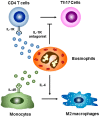Regulatory Eosinophils in Inflammation and Metabolic Disorders
- PMID: 28261019
- PMCID: PMC5334121
- DOI: 10.4110/in.2017.17.1.41
Regulatory Eosinophils in Inflammation and Metabolic Disorders
Abstract
Eosinophils are potent effector cells implicated in allergic responses and helminth infections. Responding to stimuli, they release their granule-derived cytotoxic proteins and are involved in inflammatory processes. However, under homeostatic conditions, eosinophils are abundantly present in the intestine and are constantly in contact with the gut microbiota and maintain the balance of immune responses without inflammation. This situation indicates that intestinal eosinophils have an anti-inflammatory function unlike allergic eosinophils. In support of this notion, some papers have shown that eosinophils have different phenotypes depending on the site of residence and are a heterogeneous cell population. Recently, it was reported that eosinophils in the small intestine and adipose tissue, respectively, contribute to homeostasis of intestinal immune responses and metabolism. Accordingly, in this review, we summarize new functions of eosinophils demonstrated in recent studies and discuss their homeostatic functions.
Keywords: Anti-inflammation; Eosinophils; IL-1R antagonist; IL-4; IgA; Th17 cells.
Figures

Similar articles
-
Homeostatic Eosinophils: Characteristics and Functions.Front Med (Lausanne). 2017 Jul 11;4:101. doi: 10.3389/fmed.2017.00101. eCollection 2017. Front Med (Lausanne). 2017. PMID: 28744457 Free PMC article. Review.
-
Small intestinal eosinophils regulate Th17 cells by producing IL-1 receptor antagonist.J Exp Med. 2016 Apr 4;213(4):555-67. doi: 10.1084/jem.20141388. Epub 2016 Mar 7. J Exp Med. 2016. PMID: 26951334 Free PMC article.
-
Eosinophils in Homeostasis and Their Contrasting Roles during Inflammation and Helminth Infections.Crit Rev Immunol. 2016;36(3):193-238. doi: 10.1615/CritRevImmunol.2016018726. Crit Rev Immunol. 2016. PMID: 28008805 Review.
-
Intestinal eosinophils, homeostasis and response to bacterial intrusion.Semin Immunopathol. 2021 Jun;43(3):295-306. doi: 10.1007/s00281-021-00856-x. Epub 2021 Apr 30. Semin Immunopathol. 2021. PMID: 33929602 Free PMC article. Review.
-
Roles and regulation of gastrointestinal eosinophils in immunity and disease.J Immunol. 2014 Aug 1;193(3):999-1005. doi: 10.4049/jimmunol.1400413. J Immunol. 2014. PMID: 25049430 Free PMC article. Review.
Cited by
-
Adjusted association between type 2 immunity and low risk thyroid nodules: a retrospective cohort study.BMC Endocr Disord. 2022 Jan 4;22(1):2. doi: 10.1186/s12902-021-00917-0. BMC Endocr Disord. 2022. PMID: 34983483 Free PMC article.
-
A role of eosinophils in mediating the anti-tumour effect of cryo-thermal treatment.Sci Rep. 2019 Sep 13;9(1):13214. doi: 10.1038/s41598-019-49734-5. Sci Rep. 2019. PMID: 31519961 Free PMC article.
-
Immune Activation in Functional Gastrointestinal Disorders.Gastroenterol Hepatol (N Y). 2019 Oct;15(10):539-548. Gastroenterol Hepatol (N Y). 2019. PMID: 31802978 Free PMC article.
-
Kawasaki Disease and Allergic Diseases.Front Pediatr. 2021 Jan 7;8:614386. doi: 10.3389/fped.2020.614386. eCollection 2020. Front Pediatr. 2021. PMID: 33490002 Free PMC article. Review.
-
The Immune and Non-Immune Pathways That Drive Chronic Gastrointestinal Helminth Burdens in the Wild.Front Immunol. 2018 Feb 5;9:56. doi: 10.3389/fimmu.2018.00056. eCollection 2018. Front Immunol. 2018. PMID: 29459856 Free PMC article.
References
-
- Rothenberg ME, Hogan SP. The Eosinophil. Annu Rev Immunol. 2006;24:147–174. - PubMed
-
- Garcia NV, Umemoto E, Sito Y, Yamasaki M, Hata E, Matozaki T, Murakami M, Jung YJ, Woo SY, Seoh JY, Jang MH, Aozasa K, Miyasaka M. SIRPα/CD172a regulates eosinophil homeostasis. J Immunol. 2011;187:2268–2277. - PubMed
-
- Carlens J, Wahl B, Ballmaier M, Bulfone-Paus S, Förster R, Pabst O. Common γ-chain-dependent signal confer selevtive survival of eosinophils in the murine small intestine. J Immunol. 2009;183:5600–5607. - PubMed
Publication types
LinkOut - more resources
Full Text Sources
Other Literature Sources
Miscellaneous

